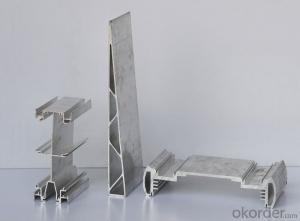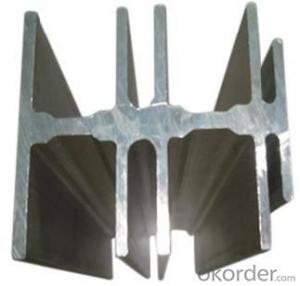aluminium profile for Industry
- Loading Port:
- China Main Port
- Payment Terms:
- TT OR LC
- Min Order Qty:
- -
- Supply Capability:
- -
OKorder Service Pledge
Quality Product, Order Online Tracking, Timely Delivery
OKorder Financial Service
Credit Rating, Credit Services, Credit Purchasing
You Might Also Like
Material | Alloy 6063,6061,6005or according to customer’s choice |
Temper | T3, T4, T5, T6 |
Surface | Anodize, electrophoresis, powder coating, PVDF coating, wood grain painting, matted, etc. |
Color | Any colour based on Standard Germany RAL Mark |
Length | Coating 6.5 meters, Anodizing 6.5 meters, Mill finish 5 meters |
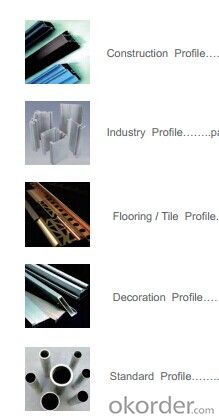

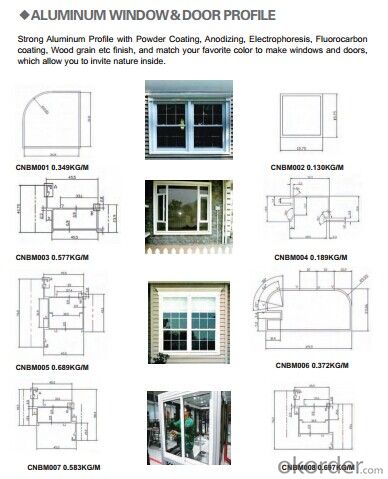
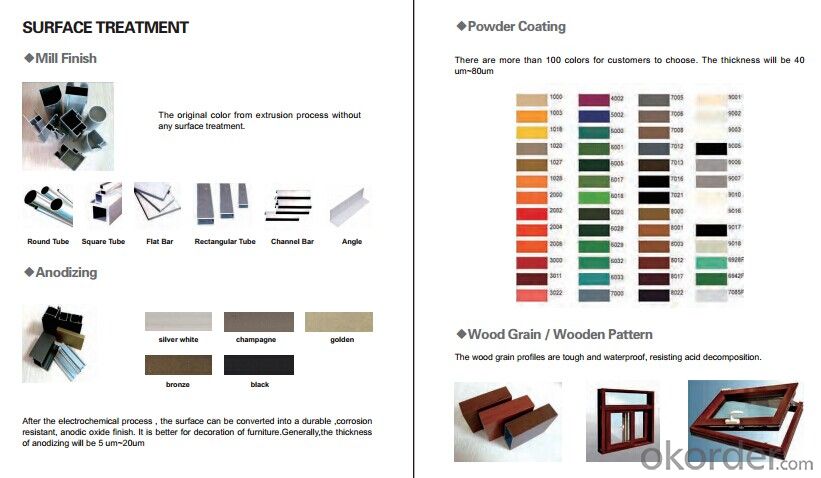
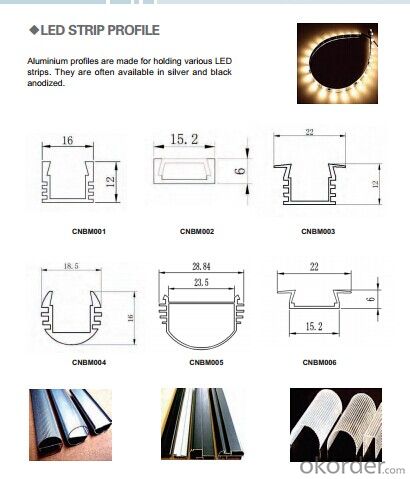
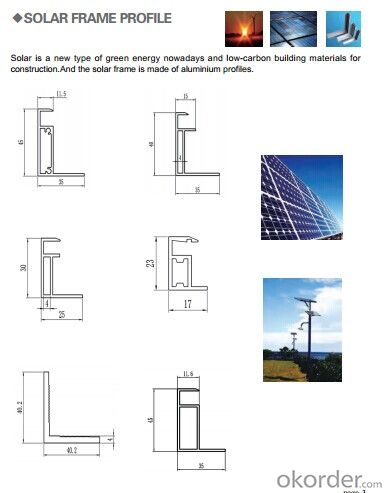
- Q:Can aluminum profiles be customized according to specific requirements?
- Indeed, specific requirements can be accommodated through the customization of aluminum profiles. This adaptable material can be effortlessly manipulated, trimmed, and formed to adhere to diverse design specifications. The dimensions, shape, thickness, and surface finish of aluminum profiles can all be personalized. Furthermore, drilling, bending, welding, and powder coating are additional processes that can be employed to further tailor aluminum profiles, achieving desired functionality and aesthetic allure. Such customizability renders aluminum profiles fitting for an extensive array of applications across industries, including construction, automotive, aerospace, and electronics.
- Q:Can aluminum profiles be used in the construction of solar panels?
- Yes, aluminum profiles can be used in the construction of solar panels. Aluminum is a lightweight and durable material that is resistant to corrosion, making it ideal for framing and mounting solar panels. It provides structural support, helps with heat dissipation, and can be easily customized to fit various panel sizes and configurations.
- Q:How do you ensure proper alignment and accuracy when using aluminum profiles?
- To ensure proper alignment and accuracy when using aluminum profiles, several steps can be followed. Firstly, it is crucial to use high-quality aluminum profiles that are manufactured with precision. This ensures that the profiles are straight and have consistent dimensions. Secondly, before assembling the profiles, it is essential to carefully measure and mark the desired positions for joints, holes, or connections. Accurate measurements and markings help in aligning the profiles correctly. Thirdly, using appropriate tools like corner clamps or angle measuring tools can aid in aligning the profiles accurately at the desired angles. These tools help in holding the profiles securely in place during the assembly process. Additionally, using leveling or straight edges can help in ensuring that the profiles are aligned correctly in terms of height or flatness. Regularly checking the alignment during the assembly process and making necessary adjustments is also crucial. Finally, it is essential to follow the manufacturer's guidelines and recommendations for assembly techniques, fasteners, and accessories. Adhering to these instructions ensures that the profiles are accurately aligned and securely fastened, resulting in proper alignment and accuracy.
- Q:What is the cost of aluminum profiles?
- Several factors can impact the cost of aluminum profiles, including the type of profile, required length and thickness, and prevailing market conditions. Typically, aluminum profiles are priced per linear foot or meter. Moreover, the price might be affected by the quality of the aluminum utilized and any necessary additional finishes or treatments. To obtain precise pricing details, it is recommended to reach out to local suppliers or manufacturers, as pricing can vary across regions.
- Q:What is the thickness of the aluminum alloy window frame?
- According to the provisions of GB5237.1-2008, aluminum profile wall thickness not less than 1.2mm. The size of the wall must be calculated after the pressure bearing is calculated.
- Q:How are aluminum profiles insulated?
- There are several methods available to enhance the thermal performance of aluminum profiles. One way is to incorporate a thermal break into the profile design. This involves inserting a non-conductive material, such as polyamide or polyurethane, between the inner and outer parts of the profile. By doing so, heat transfer between the interior and exterior of a building is minimized, resulting in improved energy efficiency. Another approach to insulating aluminum profiles is to apply insulating materials, such as foam or rubber, to either the interior or exterior surfaces of the profile. These materials act as barriers, reducing heat transfer and providing additional insulation. Additionally, insulating gaskets or seals can be fitted to aluminum profiles. These gaskets, typically made of rubber or other insulating materials, are positioned between the profile and the glazing. They create a thermal barrier, preventing heat loss or gain. In summary, the insulation of aluminum profiles can be achieved through the incorporation of thermal breaks, the application of insulating materials, or the use of gaskets. These methods effectively minimize heat transfer and enhance the energy efficiency of buildings.
- Q:Can aluminum profiles be used for electrical bus ducts?
- Indeed, electrical bus ducts can be constructed using aluminum profiles. Within the electrical industry, aluminum is widely employed as it possesses exceptional conductivity and lightweight characteristics. Its remarkable electrical conductivity plays a vital role in efficiently transmitting electrical power. Furthermore, aluminum profiles exhibit durability, resistance to corrosion, and the ability to endure high temperatures, rendering them suitable for diverse industrial applications. Nonetheless, it is crucial to carefully assess the project's unique requirements and regulations in order to ascertain that the aluminum profiles conform to the essential electrical and safety standards.
- Q:What are the different bending radii available for aluminum profiles?
- Depending on the specific application requirements, the available bending radii for aluminum profiles can vary. However, aluminum profiles typically offer a range of bending radii options to accommodate different needs. Common bending radii for aluminum profiles include 1.5D, 2D, 3D, and 4D. In these radii, the "D" refers to the outer diameter of the profile. For instance, a 1.5D bending radius indicates that the bend radius is 1.5 times the outer diameter of the profile. The choice of bending radius depends on various factors, such as the thickness and alloy of the aluminum, the desired bending angle, and the intended application. Smaller bending radii are often employed for tighter bends or when a more compact design is necessary. Conversely, larger bending radii are suitable for gentler bends or when maintaining the structural integrity of the profile is crucial. It is important to note that the bending process can impact the mechanical properties of the aluminum profile, including its strength and stiffness. Therefore, it is crucial to carefully consider the bending radius to ensure that the profile retains its desired properties post-bending. To determine the most appropriate bending radius for a specific aluminum profile, it is advisable to seek guidance from manufacturers or experts knowledgeable in aluminum bending processes. They can offer valuable insights based on the specific requirements and limitations of the application.
- Q:What is the difference between aluminum alloy and 6063-T5 6060-T66?
- 6060-T66, higher strength, average mechanical performance is higher than T6 under 20-30Mpa condition [T66 is in T6 (solid solution strengthening + fully artificial aging) condition, strengthened by special process status - in European standard can be found] 6063-T5 is the most common aluminum alloy and delivery condition, and most of the architectural profiles are applied
- Q:Can aluminum profiles be used in the construction of exhibition stands?
- Yes, aluminum profiles can be used in the construction of exhibition stands. Aluminum profiles are lightweight, durable, and easy to work with, making them a popular choice for building exhibition stands. They can be easily cut, shaped, and assembled to create custom designs that meet the specific requirements of the exhibition. Additionally, aluminum profiles can be powder-coated or anodized to provide a wide range of finishes, enhancing the aesthetic appeal of the exhibition stand. Furthermore, aluminum is resistant to corrosion and can withstand various weather conditions, ensuring the longevity of the exhibition stand. Overall, using aluminum profiles in the construction of exhibition stands offers flexibility, durability, and a sleek appearance.
1. Manufacturer Overview |
|
|---|---|
| Location | |
| Year Established | |
| Annual Output Value | |
| Main Markets | |
| Company Certifications | |
2. Manufacturer Certificates |
|
|---|---|
| a) Certification Name | |
| Range | |
| Reference | |
| Validity Period | |
3. Manufacturer Capability |
|
|---|---|
| a)Trade Capacity | |
| Nearest Port | |
| Export Percentage | |
| No.of Employees in Trade Department | |
| Language Spoken: | |
| b)Factory Information | |
| Factory Size: | |
| No. of Production Lines | |
| Contract Manufacturing | |
| Product Price Range | |
Send your message to us
aluminium profile for Industry
- Loading Port:
- China Main Port
- Payment Terms:
- TT OR LC
- Min Order Qty:
- -
- Supply Capability:
- -
OKorder Service Pledge
Quality Product, Order Online Tracking, Timely Delivery
OKorder Financial Service
Credit Rating, Credit Services, Credit Purchasing
Similar products
New products
Hot products
Related keywords
